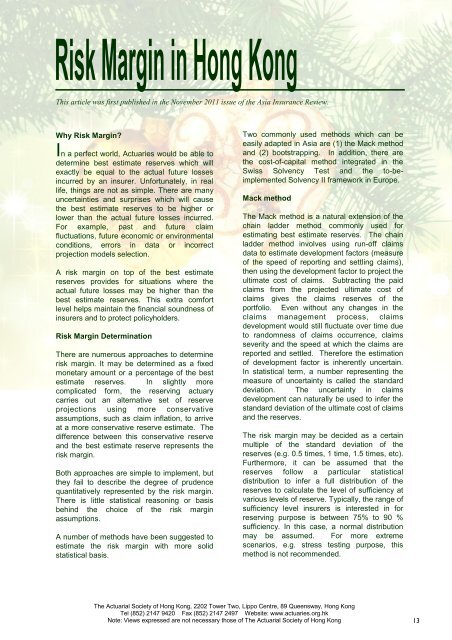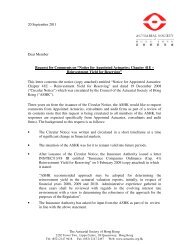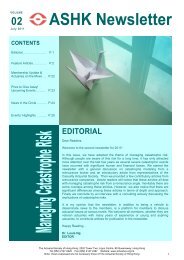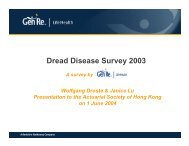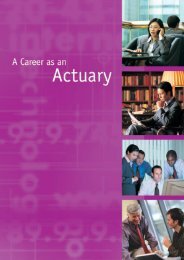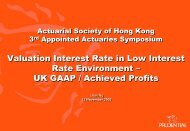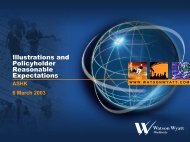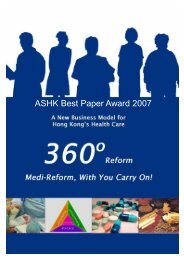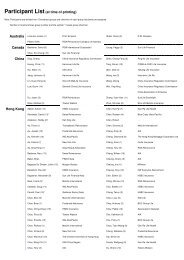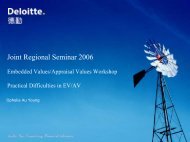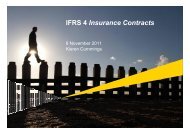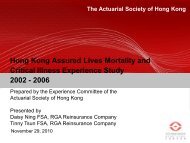Newsletter-volume 4 - 2011 (Draft) - Actuarial Society of Hong Kong
Newsletter-volume 4 - 2011 (Draft) - Actuarial Society of Hong Kong
Newsletter-volume 4 - 2011 (Draft) - Actuarial Society of Hong Kong
- No tags were found...
Create successful ePaper yourself
Turn your PDF publications into a flip-book with our unique Google optimized e-Paper software.
This article was first published in the November <strong>2011</strong> issue <strong>of</strong> the Asia Insurance Review.Why Risk Margin?In a perfect world, Actuaries would be able todetermine best estimate reserves which willexactly be equal to the actual future lossesincurred by an insurer. Unfortunately, in reallife, things are not as simple. There are manyuncertainties and surprises which will causethe best estimate reserves to be higher orlower than the actual future losses incurred.For example, past and future claimfluctuations, future economic or environmentalconditions, errors in data or incorrectprojection models selection.A risk margin on top <strong>of</strong> the best estimatereserves provides for situations where theactual future losses may be higher than thebest estimate reserves. This extra comfortlevel helps maintain the financial soundness <strong>of</strong>insurers and to protect policyholders.Risk Margin DeterminationThere are numerous approaches to determinerisk margin. It may be determined as a fixedmonetary amount or a percentage <strong>of</strong> the bestestimate reserves. In slightly morecomplicated form, the reserving actuarycarries out an alternative set <strong>of</strong> reserveprojections using more conservativeassumptions, such as claim inflation, to arriveat a more conservative reserve estimate. Thedifference between this conservative reserveand the best estimate reserve represents therisk margin.Both approaches are simple to implement, butthey fail to describe the degree <strong>of</strong> prudencequantitatively represented by the risk margin.There is little statistical reasoning or basisbehind the choice <strong>of</strong> the risk marginassumptions.A number <strong>of</strong> methods have been suggested toestimate the risk margin with more solidstatistical basis.Two commonly used methods which can beeasily adapted in Asia are (1) the Mack methodand (2) bootstrapping. In addition, there arethe cost-<strong>of</strong>-capital method integrated in theSwiss Solvency Test and the to-beimplementedSolvency II framework in Europe.Mack methodThe Mack method is a natural extension <strong>of</strong> thechain ladder method commonly used forestimating best estimate reserves. The chainladder method involves using run-<strong>of</strong>f claimsdata to estimate development factors (measure<strong>of</strong> the speed <strong>of</strong> reporting and settling claims),then using the development factor to project theultimate cost <strong>of</strong> claims. Subtracting the paidclaims from the projected ultimate cost <strong>of</strong>claims gives the claims reserves <strong>of</strong> theportfolio. Even without any changes in theclaims management process, claimsdevelopment would still fluctuate over time dueto randomness <strong>of</strong> claims occurrence, claimsseverity and the speed at which the claims arereported and settled. Therefore the estimation<strong>of</strong> development factor is inherently uncertain.In statistical term, a number representing themeasure <strong>of</strong> uncertainty is called the standarddeviation. The uncertainty in claimsdevelopment can naturally be used to infer thestandard deviation <strong>of</strong> the ultimate cost <strong>of</strong> claimsand the reserves.The risk margin may be decided as a certainmultiple <strong>of</strong> the standard deviation <strong>of</strong> thereserves (e.g. 0.5 times, 1 time, 1.5 times, etc).Furthermore, it can be assumed that thereserves follow a particular statisticaldistribution to infer a full distribution <strong>of</strong> thereserves to calculate the level <strong>of</strong> sufficiency atvarious levels <strong>of</strong> reserve. Typically, the range <strong>of</strong>sufficiency level insurers is interested in forreserving purpose is between 75% to 90 %sufficiency. In this case, a normal distributionmay be assumed. For more extremescenarios, e.g. stress testing purpose, thismethod is not recommended.The <strong>Actuarial</strong> <strong>Society</strong> <strong>of</strong> <strong>Hong</strong> <strong>Kong</strong>, 2202 Tower Two, Lippo Centre, 89 Queensway, <strong>Hong</strong> <strong>Kong</strong>Tel (852) 2147 9420 Fax (852) 2147 2497 Website: www.actuaries.org.hkNote: Views expressed are not necessary those <strong>of</strong> The <strong>Actuarial</strong> <strong>Society</strong> <strong>of</strong> <strong>Hong</strong> <strong>Kong</strong>13


